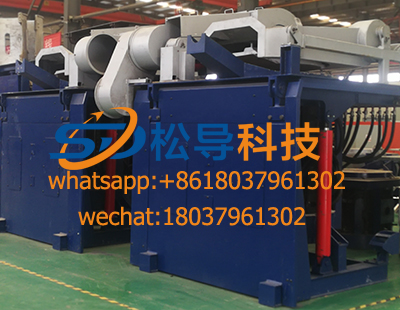Maintenance of common faults of medium frequency electric furnace
1.1 Fault phenomenon The intermediate frequency furnace runs normally and often breaks down the compensation capacitor.

Analysis and treatment of the cause of the failure:
(1) The IF voltage and operating frequency are too high;
(2) The capacitor configuration is not enough;
(3) In the capacitor boost circuit, the capacitance difference between the series capacitor and the shunt capacitor is too large, resulting in a voltage uneven breakdown capacitor;
(4) The cooling does not break through the capacitor.
1.9. DC smoothing reactor
Fault phenomenon The IF furnace works unstable and the electrical parameters fluctuate. The intermediate frequency electric furnace has abnormal sounds frequently appearing, overcurrent protection and burning of the fast thyristor.
Analysis and Processing In the maintenance of intermediate frequency power supply, the fault of DC smoothing reactor is a fault that is difficult to judge and handle. The faults that occur in DC smoothing reactors are:
(1) The user can adjust the air gap and coil turns of the reactor at will, change the inductance of the reactor, affect the filter power of the reactor, and make the DC current of the output appear intermittent, resulting in unstable operation of the inverter bridge. Inverter, failure to burn the inverter thyristor to adjust the air gap of the small reactor and reduce the number of coil turns. When the inverter bridge is short-circuited, it will reduce the blocking current of the reactor.
The ability to rise, burning the thyristor to change the inductance of the reactor at will also affect the starting performance of the intermediate frequency electric furnace;
(2) The reactor coil is loose. If the coil of the reactor is loose, when the electromagnetic force causes the coil jitter coil to vibrate during the operation of the intermediate frequency electric furnace, the sudden change of the inductance is likely to cause the inverter failure during the light load start and the small current operation;
(3) The reactor coil insulation is not good. Short circuit to ground or short circuit between turns, sparking discharge causes the inductance of the reactor, sudden jump and strong electromagnetic interference make the intermediate frequency electric furnace work unstable and produce abnormal sound frequently. The overcurrent blows the thyristor and causes the insulation of the coil insulation layer to be short. : a. The cooling is not good, the temperature is too high, causing the insulation layer to become poorly insulated and pyrophoric; b. The reactor coil is loose, between the coil insulation layer and the coil insulation layer, between the coil insulation layer and the iron core, and the relative motion friction causes the insulation layer Corruption; c. When dealing with the scale of the reactor coil, the acid is infiltrated into the coil, and the acid corrodes the copper tube and forms a copper salt to destroy the insulating layer.
1.9. Thyristor
(1) Symptom After the thyristor is replaced, the thyristor is burned as soon as it is turned on.
Analyze and deal with the failure of the intermediate frequency electric furnace to burn the thyristor. Do not turn on the thyristor immediately after replacing the new thyristor. Firstly, the system should be checked and trouble-shooted by the intermediate frequency electric furnace. If the intermediate frequency electric furnace is found to be fault-free, if it is turned on again, it will appear to be burned when it is turned on. The phenomenon of thyristors. When pressing a new thyristor, it is necessary to pay attention to the pressure equalization. Otherwise, the chip inside the thyristor will be mechanically damaged, resulting in a significant drop in the withstand voltage of the thyristor, and the phenomenon of burning the thyristor when the power is turned on.
(2) Symptom After the replacement of the new thyristor, the power is turned on normally but the thyristor is burned for a while.
Analytical processing The reasons for this type of failure are:
(3) The electrical characteristics of the electrical components in the control section are not good;
(4) The thyristor and the heat sink are installed misaligned;
(5) The radiator is used repeatedly or press-fitted through a small table thyristor, causing the center of the radiator table to be recessed, resulting in poor contact between the radiator table and the thyristor table surface and burning the thyristor;
(6) The scale in the radiator water chamber is too thick and the heat conduction is not good, causing the components to overheat and burn off;
(7) The rapid thyristor temperature rises due to poor heat dissipation, and the turn-off time of the thyristor increases with the increase of temperature, eventually causing the component not to be turned off, causing the inverter to subvert and burn off the thyristor;
(1) The working temperature of the thyristor is too high, the gate parameter is reduced, and the anti-interference ability is reduced, which is easy to cause false triggering damage to the thyristor and the intermediate frequency electric furnace;
(9) Check if the RC absorption circuit is intact.
(10) Fault phenomenon After replacing the new thyristor, the intermediate frequency electric furnace still cannot work normally to burn the thyristor.
Analysis and treatment After the failure of the intermediate frequency electric furnace, the thyristor is burned and replaced with a new thyristor. After the static detection of the intermediate frequency furnace is normal, it still cannot work normally and is easy to burn the thyristor. At this time, it is necessary to pay special attention to whether the pulse transformer, the power transformer, the intermediate frequency transformer, the intermediate frequency isolation transformer have a poor insulation between the primary coil and the secondary coil, between the coil and the core, and between the turns and the turns.















